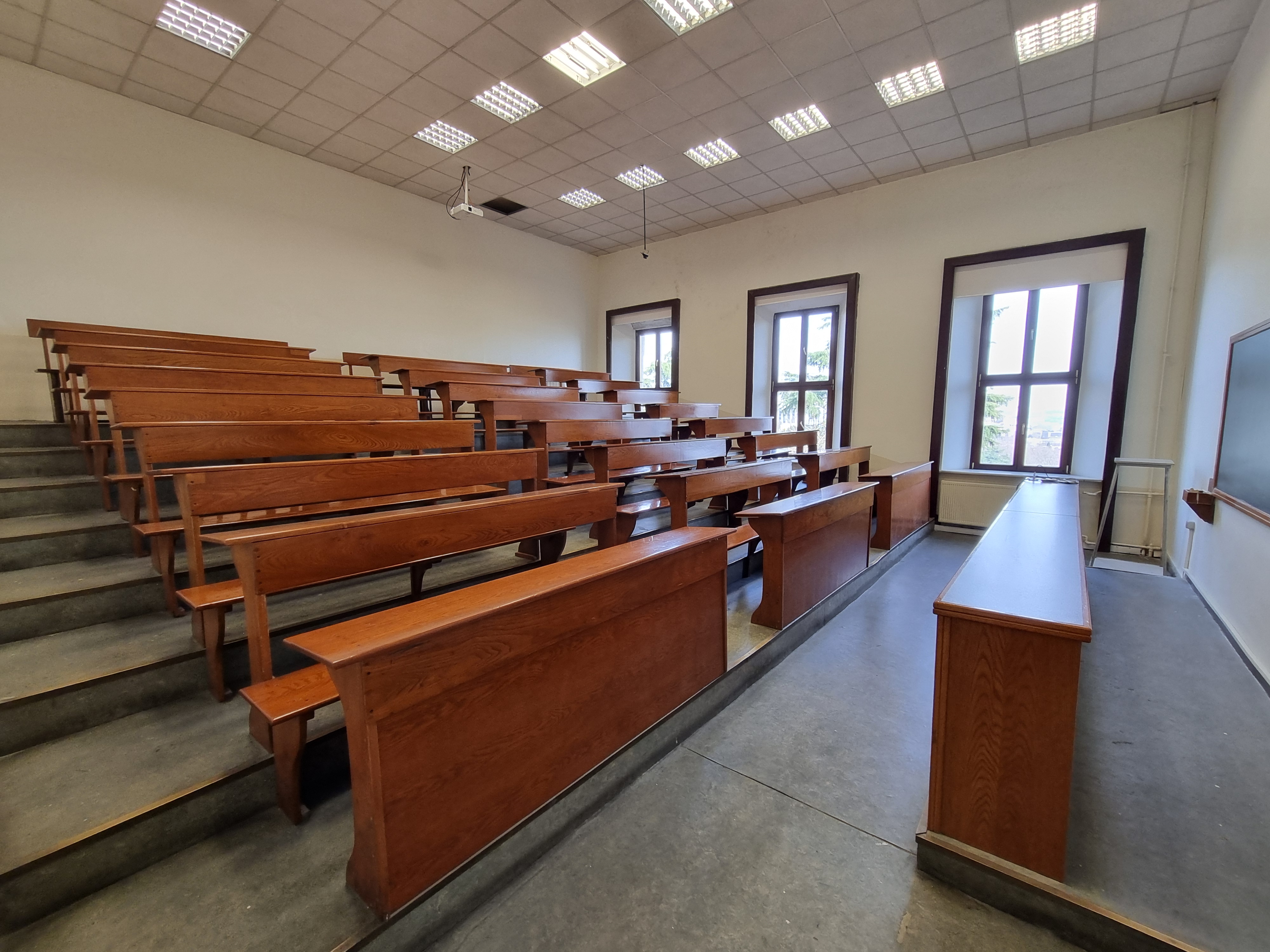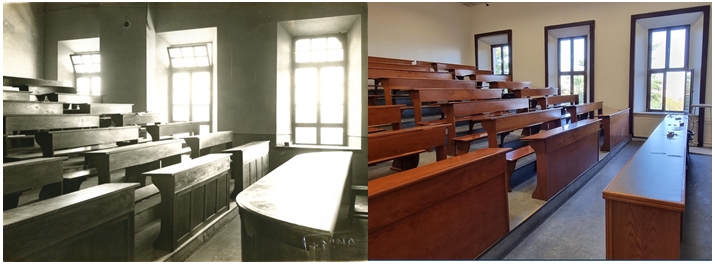The Faculty of Mechanical Engineering, one of the core faculties involved in the founding of Istanbul Technical University, such as Civil Engineering, Architecture, and Electrical Engineering, received its current name in 1944. In 1933, with the new university reform, the "Istanbul Darülfünunu" (Istanbul University) Electrical and Mechanical Institute, which was part of the Faculty of Science, was abolished, and the Electrical-Mechanical Department was opened at the Higher Engineering School, initiating Mechanical-Electrical Engineering education. In 1944, with a new law, the Higher Engineering School was renamed "Istanbul Technical University," and the Mechanical Department became an independent Faculty of Mechanical Engineering.
Our faculty is one of the oldest institutions in our country conducting education and research in the field of mechanical engineering. The various branches of engineering it houses have evolved into independent faculties. In 1969, the Faculty of Shipbuilding and Marine Sciences, in 1983, the Faculty of Aeronautics and Astronautics, and in 2004, the Faculty of Textile Technologies and Design gained their independent status. In its early years, some of the basic science and general engineering courses were also taught within the Mechanical Engineering Faculty, and the Mining Engineering Department, which was initially part of the Mechanical Faculty, became an independent faculty in 1953.
The Faculty of Mechanical Engineering, through the Department of Mechanical Engineering, carries out education and research in the design, development, and production planning of all types of mechanical systems and energy conversion systems. Research and development activities continue in various fields, such as the automotive industry, energy production, petrochemical industry, robotics technology, textile industry, defense industry and technologies, reverse engineering, clean energy, renewable energy, underground coal gasification, MEMS, nanotechnology, pharmaceutical technology, and biomolecular engineering.
Today, Istanbul Technical University's Faculty of Mechanical Engineering, which is a contemporary education and research institution compatible with world technology, is one of the faculties in our country with the largest research laboratories.
The construction of the Gümüşsuyu Building began in 1840 during the reign of Ottoman Sultan Mahmud II, with the aim of meeting the housing needs of the unmarried workers employed at the Tüfekhane-i Amire, which was located in Dolmabahçe and served as the state’s light weapon production center. During its construction, some changes were made to the interior, and it was transformed into a military barracks. The wooden building, completed in 1843 by Armenian architect Garabet Amira Balyan, was then used as the Gümüşsuyu Barracks.
In 1857, Sultan Abdülmecid requested the renovation of the dilapidated Gümüşsuyu Barracks, which was intended for use by the Hademe-i Hassa (the royal attendants) and the Muzika-i Hümayun (the Imperial Ottoman Band), who served at Dolmabahçe Palace. As a result, in 1862, the main structure of the Gümüşsuyu Barracks was converted into a Kâgire (a type of building material), and it was completed by architect Sarkis Balyan during the reign of Sultan Abdülaziz.
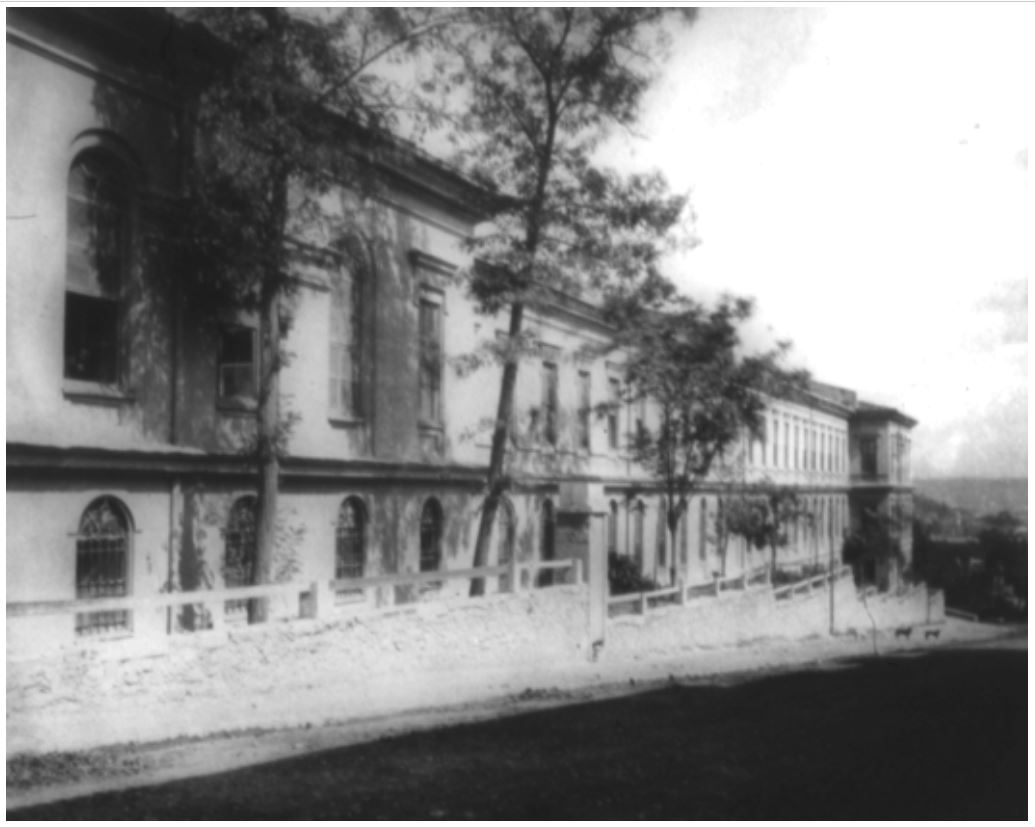
A photo of Gümüşsuyu Barracks from its early years.
During the Ottoman period, the Gümüşsuyu Barracks hosted the Muzika-i Hümayun, which was established to train musicians for the palace band and orchestra, as well as to provide Turkish music education. In this regard, it holds the distinction of being one of the first buildings of what is now the Presidential Symphony Orchestra. Additionally, the Gümüşsuyu Barracks was used for the training of the Hademe-i Hassa unit, which was responsible for performance and ceremony duties among the palace attendants. In later years, a section of the barracks was allocated to the Tulumbacılar Birliği (the Fire Brigade), which was responsible for fire-fighting duties, and the Süvari Birliği (Cavalry Unit), which served as the palace’s mounted protection unit. The area, which is now used as a gymnasium and outdoor space, was originally designated in 1863 as stables for the Süvari Birliği.
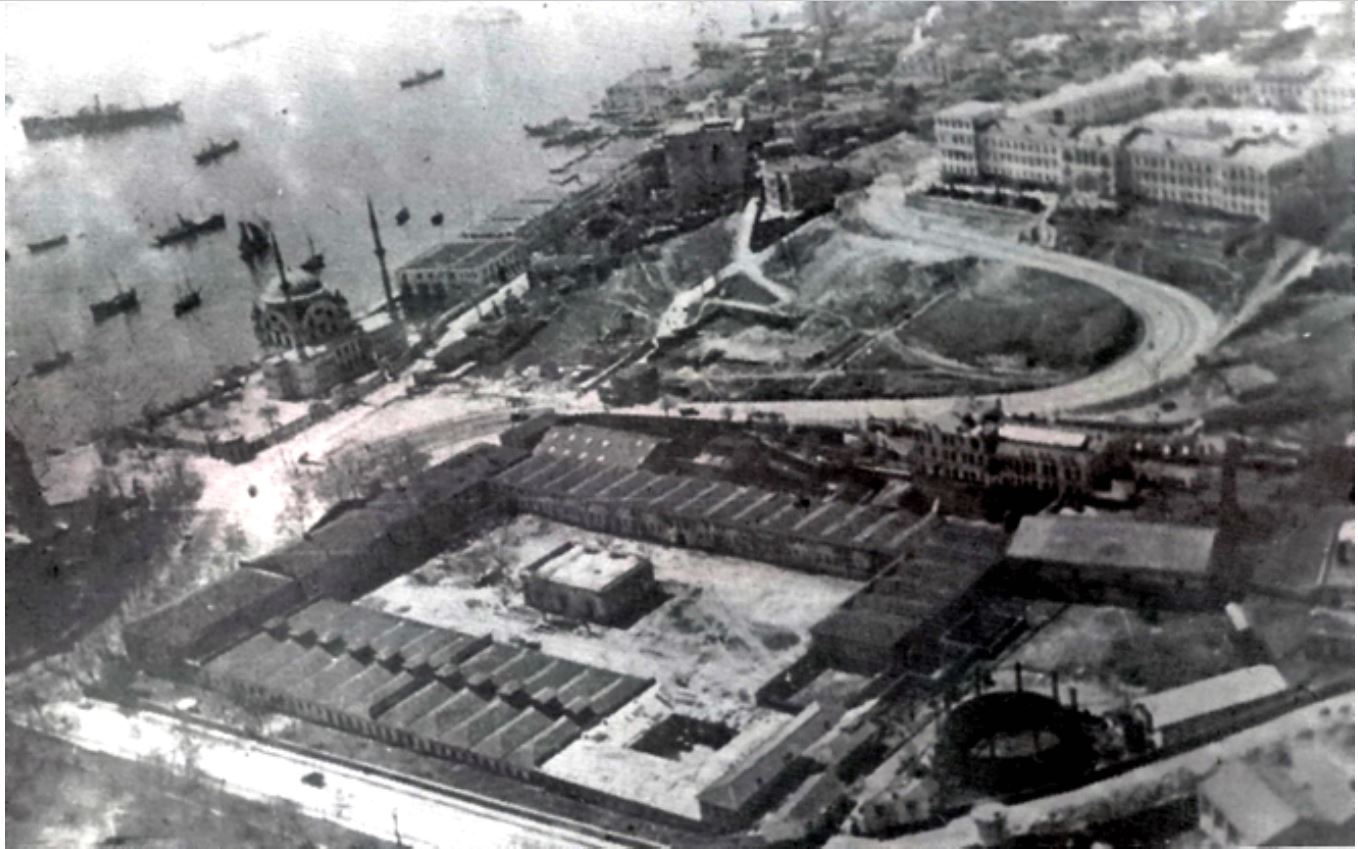
Gümüşsuyu Barracks and Dolmabahçe in the early 20th century.
In 1909, the Gümüşsuyu Barracks was damaged by a fire caused by the carelessness of soldiers serving with the map officers. Despite the efforts of the fire brigade, the delayed extinguishing of the fire resulted in significant damage.
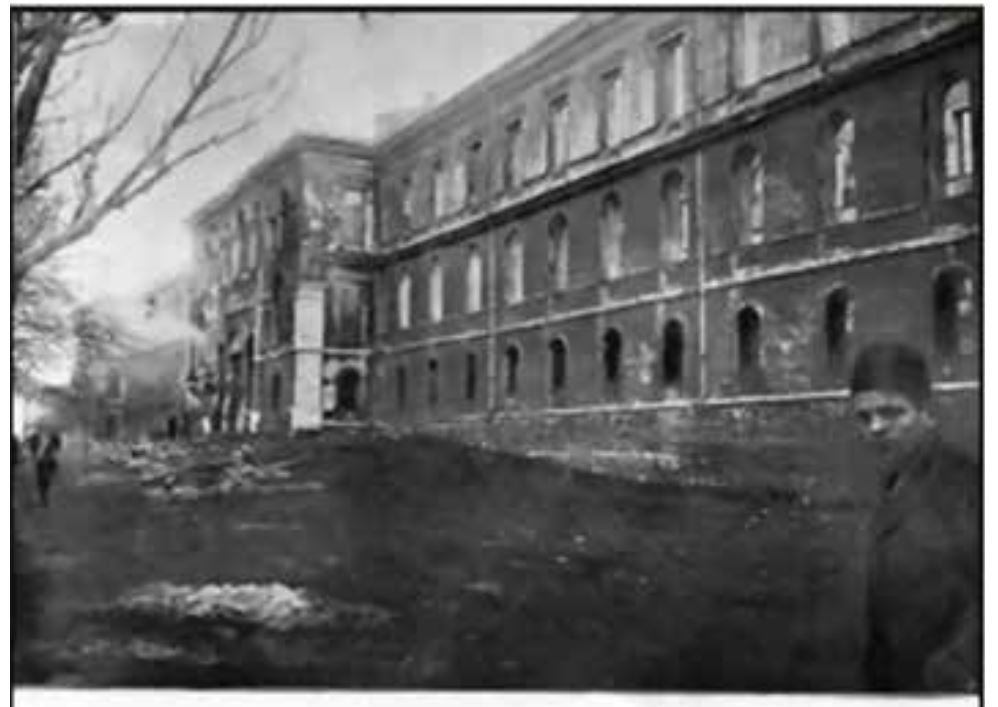
Gümüşsuyu Barracks after the fire in 1909.
Transition of Gümüşsuyu Barracks to Engineering Education
The first civilian engineering school, founded in 1884 under the name Hendese-i Mülkiye Mektebi, was affiliated with the Mühendishane-i Berri-i Hümayun and began its education at the Mühendishane in Halıcıoğlu. However, due to conflicts between military and civilian administrators, it separated from Mühendishane-i Berri-i Hümayun and, in 1909, adopted the name Mühendis Mekteb-i Âlîsi. It was then connected to the Ministry of Public Works (Nafia Nezareti) and relocated to the Faik Paşa Mansion in Tophane. Before ultimately moving to Gümüşsuyu Barracks, the engineering school had to relocate to seven different buildings, including Notre Dame de Sion and Harbiye Mektebi, due to reasons such as a typhus outbreak, World War I, and occupation.
Initially, on November 28, 1918, Gümüşsuyu Barracks was allocated to the Mühendis Mektebi by the Sultan of the time, Vahdettin. The equipment for the physics and chemistry laboratories was stored in the mosque in the middle courtyard of Gümüşsuyu Barracks. Unfortunately, a week later, before the students could settle in, the British occupied the building and started using it as a hospital. For a while, the Mühendis Mektebi, having left some of its belongings in the mosque in the middle courtyard, moved back to its old building in Halıcıoğlu. However, after the occupation of Istanbul, the building was allocated to the British forces, and the school was once again left without a place. Meanwhile, the Gümüşsuyu Barracks, used as a hospital, suffered another fire in April 1920, which completely destroyed the southern wing facing Gümüşsuyu Street.
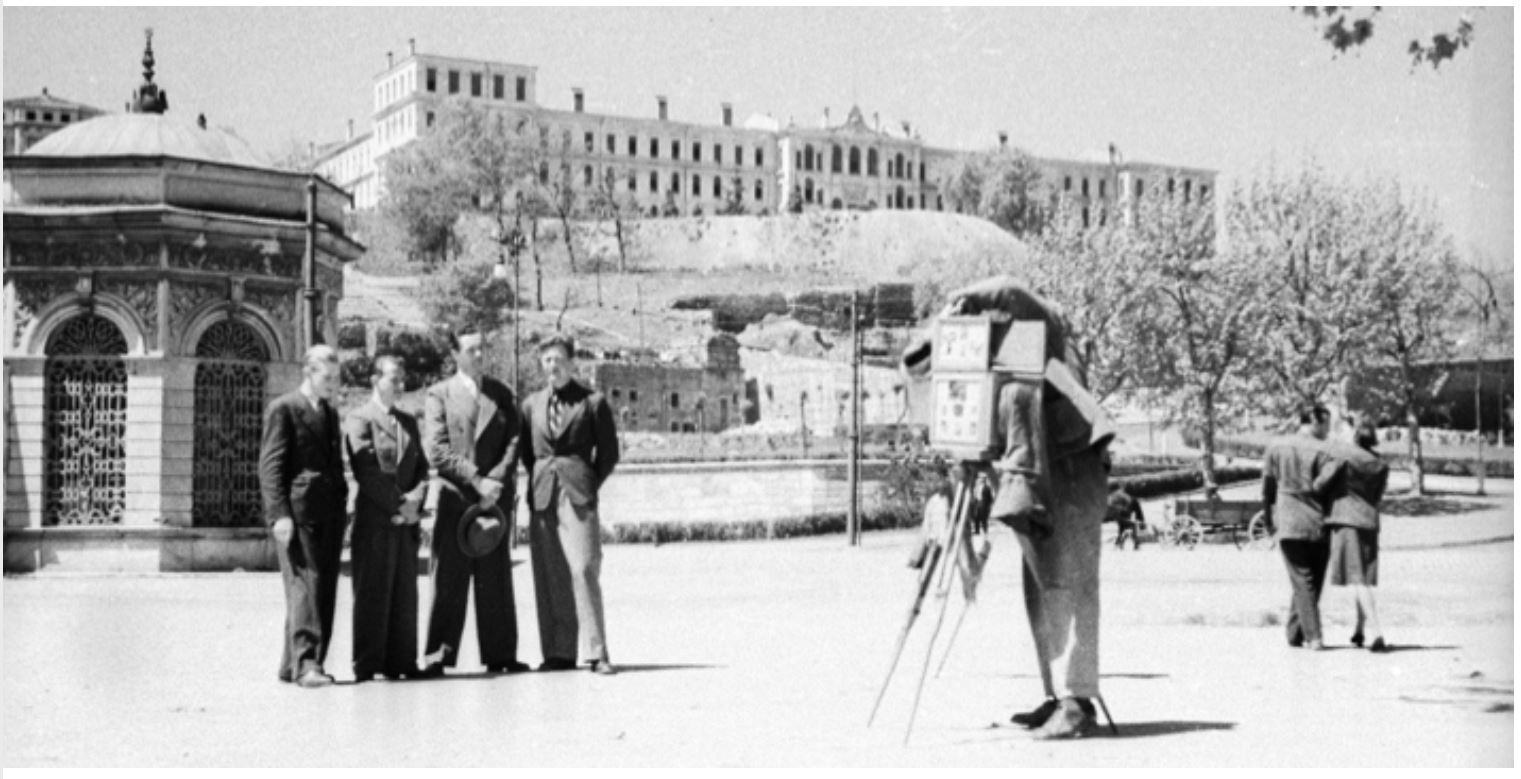
The view of the Gümüşsuyu Building from Dolmabahçe.
After the education in unsuitable buildings where classes were held in dormitories and the dining hall, the issue of relocating the School of Engineering to Gümüşsuyu Barracks was finally brought up in 1923. Following the War of Independence and the liberation of Istanbul, on March 12, 1923, the then Minister of Foreign Affairs, İsmet (İnönü) Pasha, requested from British General Harrington the evacuation of the Gümüşsuyu Barracks. In September 1923, it was decided that Gümüşsuyu Barracks would be used by both the School of Engineering and the Conductor School due to the urgent need of both schools. In 1937, the Conductor School, which had become a Technical School and was moved to Yıldız, would later be renamed Yıldız Technical University in 1992. On October 20, 1923, the School of Engineering, which had been relocated to Gümüşsuyu Barracks, started its classes.
However, the building, which had been handed over in a ruined state by the British, underwent repairs and renovation for several years. Details of the building's renovation process are provided in the research book titled "Yüksek Mühendis Okulu" (The Higher Engineering School) as follows [1]: “The southern part of the building's Sea façade (the area where the current Faculty of Mechanical Engineering secretary’s office is located and beyond) had been extensively renovated and rebuilt during Fikri Bey's first directorship. The auctioned Conference Hall and its continuation were also completed during Suphi Bey’s Rectorship. A significant portion of the walls surrounding the building and garden were rebuilt, while other parts were repaired. The garden in front of the building, facing Dolmabahçe, was arranged. After Fikri Bey, Suphi Tanıg was appointed as the director by the Ministry of Public Works on June 1, 1935.
At this time, it was decided to build a separate dormitory for the sole use of education and laboratory purposes, and the old cavalry barracks, which is now the dormitory building, was turned into a dormitory, providing excellent accommodation, rest, and dining facilities for 300 students. The parts of the Gümüşsuyu building that were used as dormitories and dining halls were dedicated to teaching. The wing of the building facing Gümüşsuyu Street was rebuilt. With these new facilities, the number of students increased, and laboratories were expanded. The restoration and expansion of the school, which had started in earlier years, continued rapidly. Of the four sections of the Gümüşsuyu building, three had already been renovated and constructed during Fikri and Suphi Bey’s time. The part facing the current Philips buildings on the western side of the Technical School was completely demolished and rebuilt with four floors.
The lower floors were allocated to printing presses, laboratories, and the upper floors were used for the library and some teaching staff. As the number of students increased, some classroom partitions were removed to expand the space. The previously small Physics and Chemistry laboratories, which could only accommodate 30 students, were expanded to twice their size. A large amphitheater was also built. The lower section of the old amphitheater was repaired and turned into a Communication laboratory. A Machine Workshop was also established for student internships. During this period, Electrical and Mechanical branches were created in the school. In addition, the departments of Aircraft Engineering and Naval Architecture were introduced.” With the law accepted on May 24, 1928, the School of Engineering, originally established as Mühendis Mekteb-i Alisi, was transformed into the Higher Engineering School, and the Gümüşsuyu Building was handed over to the institution.
During World War II, the Higher Engineering School, which expanded its staff with faculty members from abroad, has been responsible for training the country’s distinguished technical personnel since it graduated its first students in 1931. Initially located in Gümüşsuyu Barracks, the school grew with the addition of the Taşkışla and Maçka Arsenal buildings, and in 1944, it became Istanbul Technical University. After the law passed on July 20, 1944, ending the directorship of Ord. Prof. Osman Tevfik Taylan, he was appointed as the first Rector of the newly established Technical University.
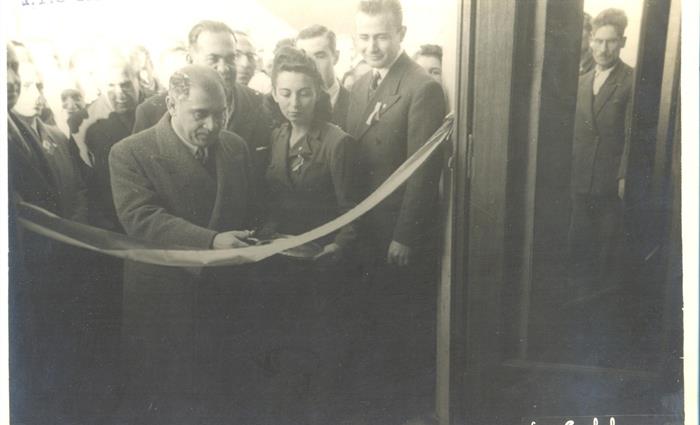
Photo from the year 1944, when Hasan Ali Yücel, the Minister of National Education of the time, cut the ribbon at the opening of Istanbul Technical University (ITU).
The Gümüşsuyu building, originally constructed for use as a military barracks, underwent many changes when transformed into an educational institution; it lost its original structure with the removal of the bathhouse and cavalry stables, and the addition of extra floors. The Meeting Room located in the Machine Faculty of the Gümüşsuyu building has been a valuable space that has hosted meetings of Rectors and Deans, both during its use as the Rectorate and afterwards. It has undergone several renovations and restorations throughout different periods, preserving its historical essence, and has become a valuable asset for our university. It is currently used for Dean and Rector meetings with a capacity of 17 people.
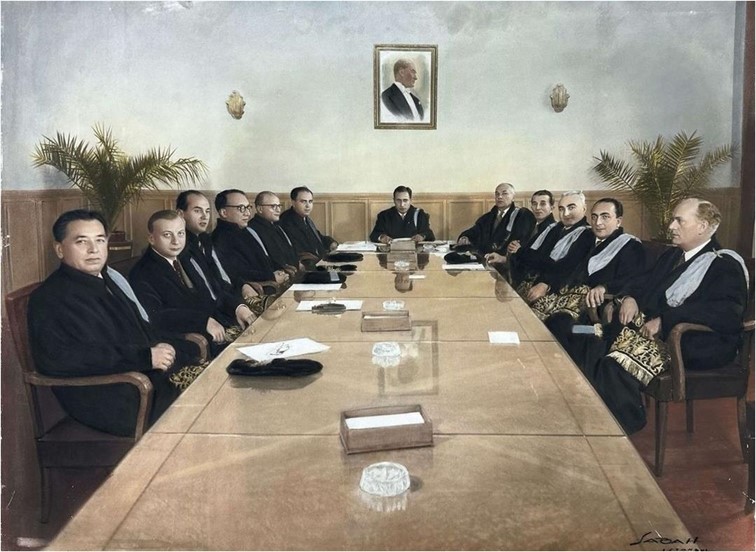
The photo above is from the 1955 meeting of the Faculty of Mechanical Engineering Professors' Board. From left to right (clockwise):
Prof. Dr. Fahri Terzioğlu (Aerospace),
Prof. Dr. Fikret Narter (Mechanical),
Prof. Dr. Kamuran Görgün (Mechanical),
Prof. Dr. Ratip Berker (Founding Dean),
Prof. Dr. Hilmi İleri (Mechanical),
Assoc. Prof. Dr. Mesut Savcı (Naval),
Prof. Dr. Hikmet Binark (Dean),
Assoc. Prof. Dr. Selim Palavan (Mechanical),
Prof. Dr. Muzaffer Sağışman (Mechanical),
Prof. Dr. Ata Nutku (Naval),
Prof. Dr. Bekir Dizioğlu (Mechanical),
Prof. Dr. François Duscio (Mechanical).
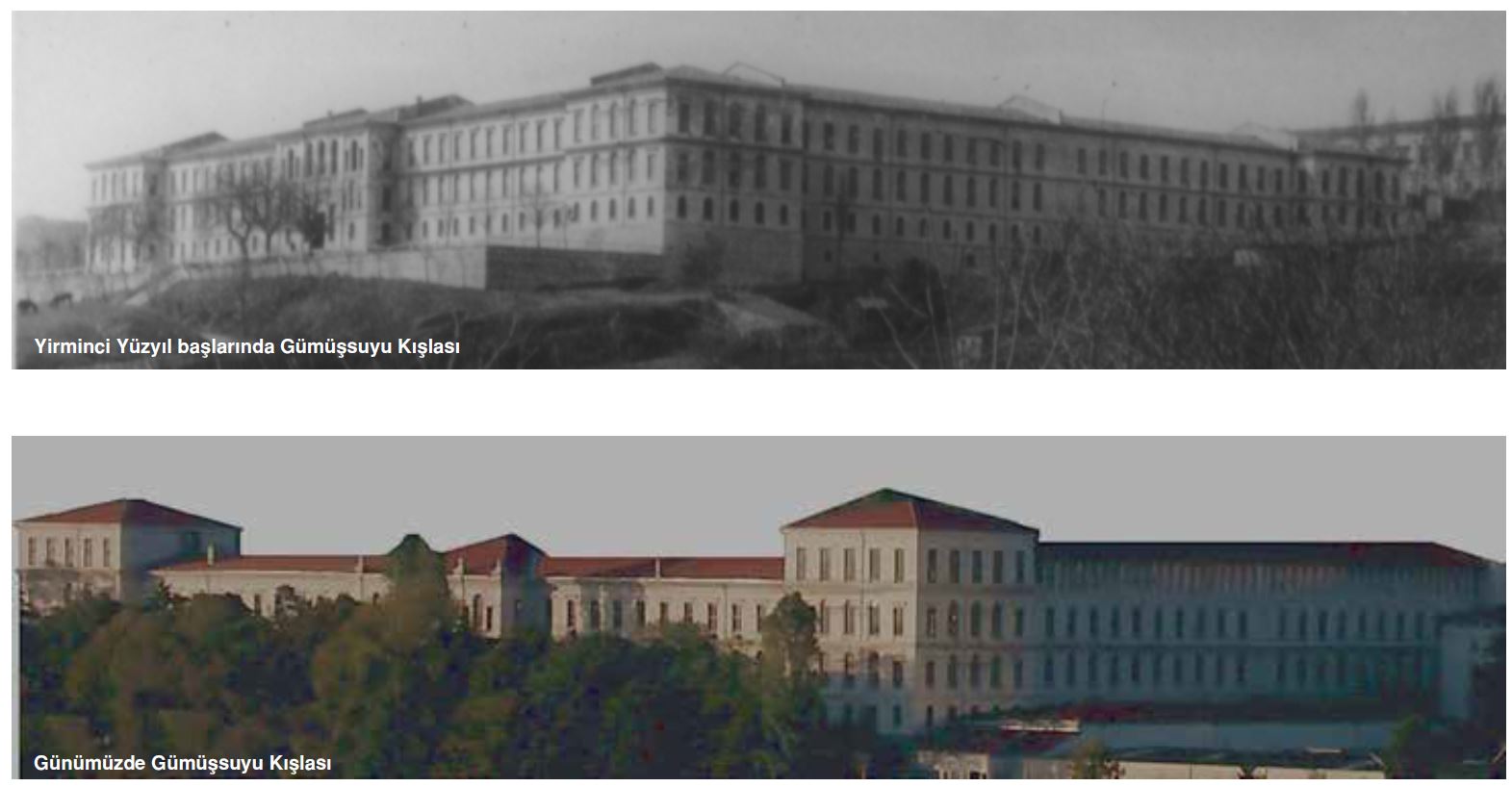
The gradual transformation of the Gümüşsuyu Campus.
[1] Uluçay Ç., Kartekin E. (1958). Yüksek Mühendis Okulu-Yüksek Mühendis ve Yüksek Mimar Yetiştiren Müesseselerin Tarihi, Berksoy Printing House, Istanbul.
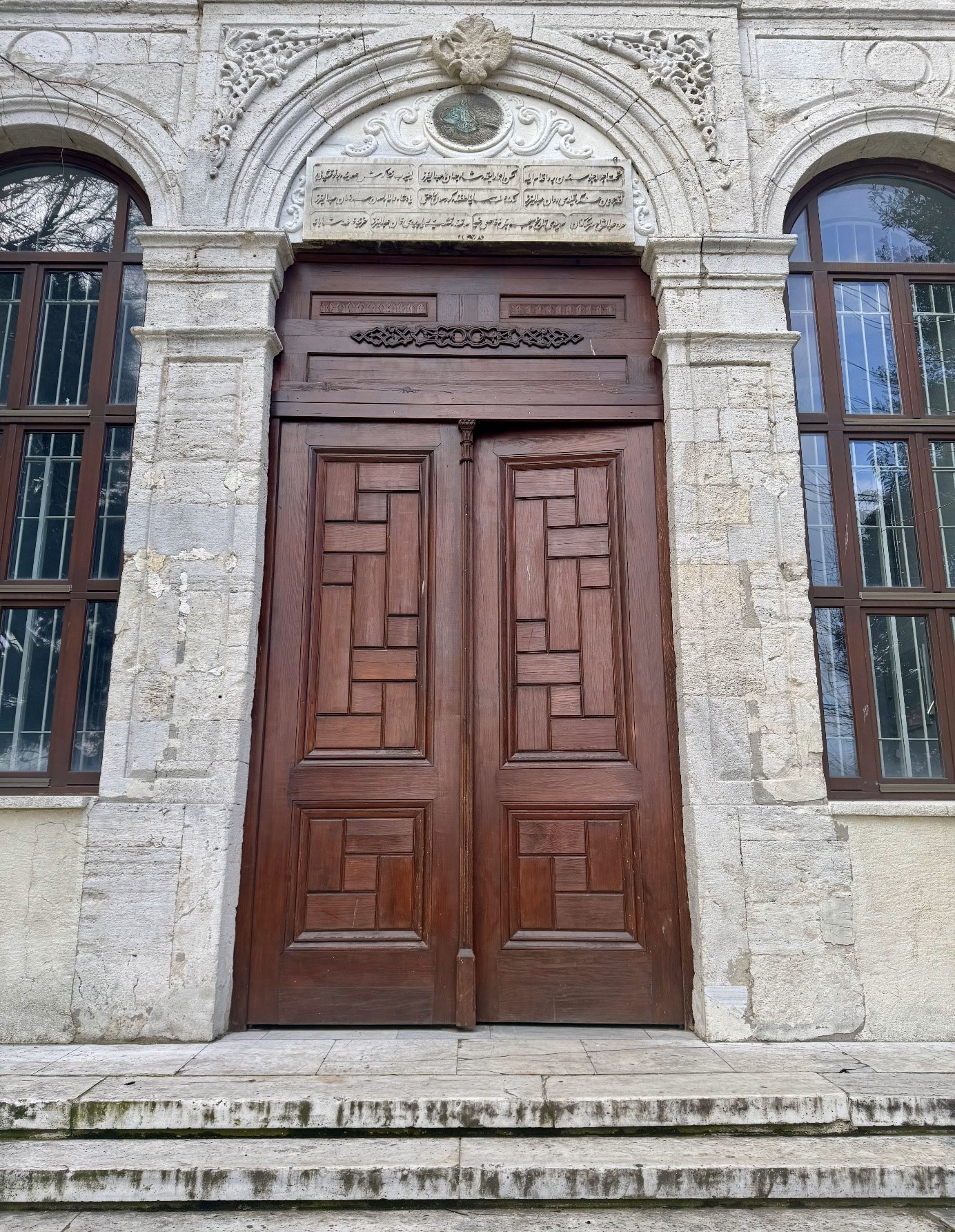
The entrance gate of the ITU Faculty of Mechanical Engineering from the front garden facing the Bosphorus.
The inscription above the historical entrance gate of the ITU Faculty of Mechanical Engineering is an important artifact documenting the construction of the barracks during the reign of Ottoman Sultan Abdulaziz. The inscription indicates the Rumi year 1278 (Gregorian 1862). Reflecting the aesthetic understanding of Ottoman calligraphy and the literary style of the period, this inscription details the construction process of the barracks and Sultan Abdulaziz’s urban development efforts. The text, written in calligraphy, is adorned with Ottoman expressions of the era and, when interpreted in modern Turkish, serves as an architectural and historical document. Below, you will find the original inscription text, its Latin script transcription, and its simplified Turkish translation.
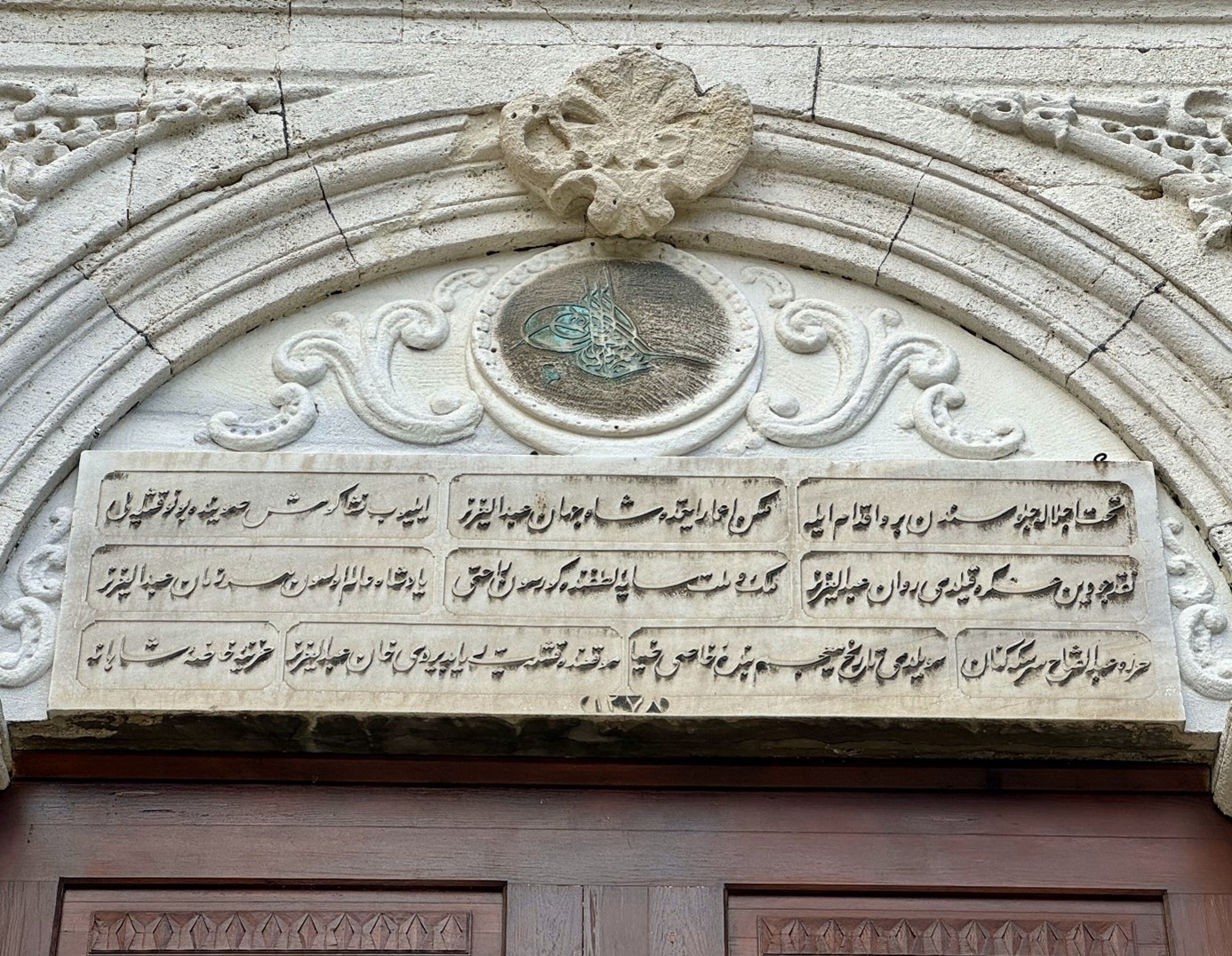
Inscription Text:
١- تحت اجلاله جلوسندن برو اقدام ايله١– تحت اجلاله جلوسندن برو اقدام ايله \\ ملكن اعمار ايتمده شاه جهان عبدالعزيز \\ ايليوب انشا كومش صوينده نو قشله يى
٢- نقد جو دين عسكره قلدى روان عبدالعزيز \\ ملك و ملت سايهء لطفنده كورسون راحتى \\ پادشاه عالم اولسون هر زمان عبدالعزيز
٣- حرره عبدالفتاح سرسكه كنان \\ سويلدى تارىخ معجم بنده خاصى ضيا \\ موقعنده قشله يي يابديردى خان عبدالعزيز \\ حزينهء خاصّهء شاهانه
٤- ١٢٧٨

Transcription:
1- Since his accession to the throne // The ruler of the world, Sultan Abdulaziz, has taken action to develop the country // And built this new barracks in Gümüşsuyu
2- Sultan Abdulaziz has generously provided for the soldiers // May the nation and people find comfort under his grace // May Sultan Abdulaziz always be the ruler of the world
3- Written by Abdulfettah, the chief of the treasury // The recorded date was given by the servant Ziya // In this location, Sultan Abdulaziz built the barracks // The Imperial Treasury
4- 1278
Calligrapher’s Signature:
Written by Abdulfettah, Chief of the Treasury, 1278 (Rumi 1862)
Simplified Translation of the Text:
Since his ascension to the throne,
The ruler of the world, Sultan Abdulaziz,
Has been developing the country.
He built this new barracks in Gümüşsuyu.
Sultan Abdulaziz generously granted it to the soldiers.
May the nation and the people find peace under his grace.
May he always be the ruler of the world.
The servant Ziya recorded the date.
Sultan Abdulaziz had the barracks built in this location.
This was written by Abdulfettah, Chief of the Imperial Treasury.
Mu’cem Date: A date calculated using only dotted letters in the abjad system.
Imperial Treasury: The administrative body managing the personal revenues and expenses of the Ottoman sultans.
Sersikkegünan: The highest-ranking official responsible for coin die preparation.
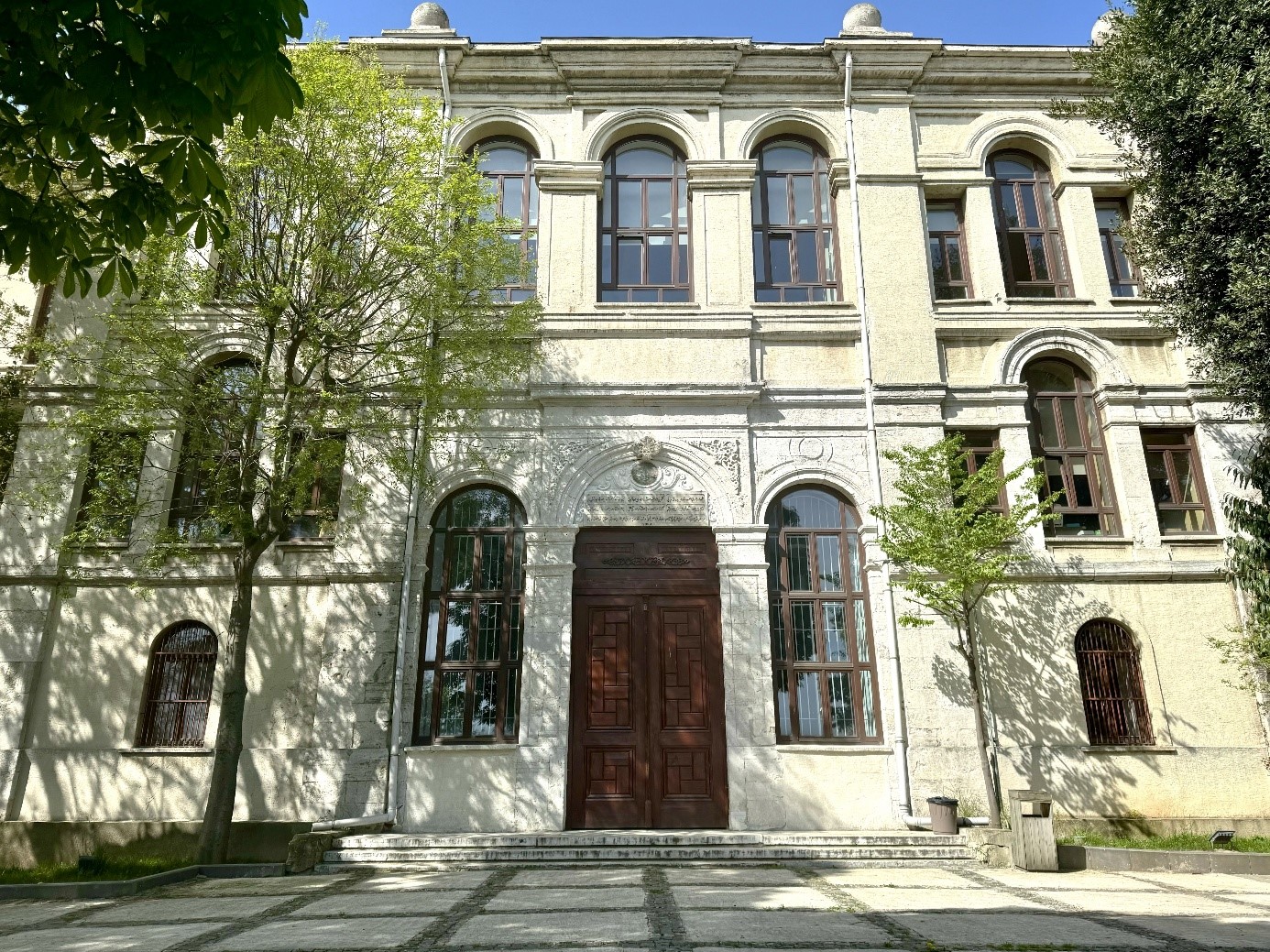
The translations were prepared by Research Assistant Kubilay Arpacı from the Department of Art History at Istanbul Medeniyet University.
This lecture hall was renovated in 1999 by the 1948 graduates of ITU Faculty of Mechanical Engineering. It is named after Prof. Dr. Lütfullah ULUKAN, who served as the Dean of ITU Faculty of Mechanical Engineering from 1959-1962 and received the TÜBİTAK Service Award in 1993. With its nostalgic wooden structure, it has hosted many advertising and cinema projects. Engineering education has been provided in this 140-person lecture hall for many years.
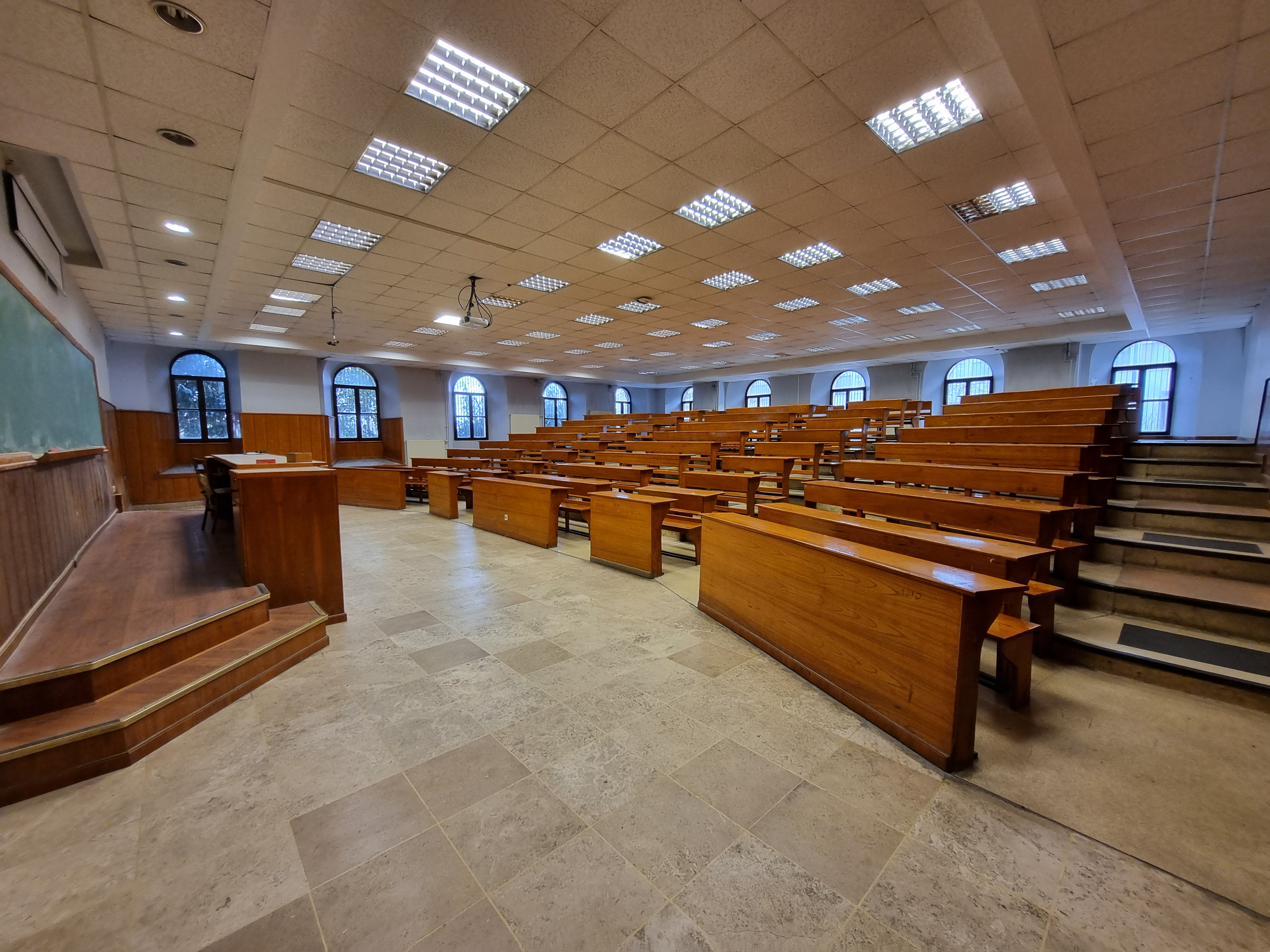
The first photo below shows the lecture hall in 1933, when it was used for physics and chemistry courses. The second photo shows the current state of the hall.

This lecture hall was built in 1997 with the funds from the III. Industrial Fair, and has a total capacity of 140 people. It is named after Prof. Dr. Saffet MÜFTÜOĞLU, the Dean of the Faculty of Mechanical Engineering, who lost his life in an attack here in 1968.
This lecture hall is named after Prof. François DUSCIO, a French mechanical engineer who played a significant role in the development of ITU's Faculty of Mechanical Engineering. Born in 1905, Prof. DUSCIO came to Turkey in 1933 and worked alongside Prof. Fikri SANTUR and Prof. Burhaneddin SEZERAR to establish the Electrical and Mechanical Engineering departments. He taught at ITU from 1944 to 1971, contributing to the education of many faculty members. He passed away in 1972. This lecture hall, with a capacity of 78 people, was renovated in 2010 by his alumni in memory of Çağatay HACIMİRZAOĞLU, who graduated in 1998.
This lecture hall, built in 1997 with the proceeds from the III. Industrial Fair, has a capacity of 180 people and is the largest lecture hall of the Faculty of Mechanical Engineering. It is named after Prof. Dr. Tarık ÖZKER, born in 1919 in Istanbul, who graduated from ITU in 1944 and worked as a faculty member until his death in 1977. He was awarded the TÜBİTAK Service Award in 1980.
The first photo below shows the lecture hall in 1933. The second photo shows Prof. Hasan Ali YÜCEL, the Minister of National Education, delivering a speech at the ITU opening ceremony in 1944.

This classroom with a view of the Bosphorus has been the site of education for many of our alumni. It maintains its nostalgic atmosphere with wooden benches. With a capacity of 72, this lecture hall is one of the oldest classrooms at ITU. The following images show the old and new states of this room.
